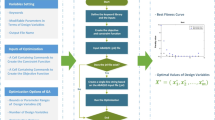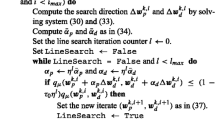Abstract
The theory of design sensitivity analysis of structures, based on mixed finite element models, is developed for static, dynamic and stability constraints. The theory is applied to the optimal design of plates with minimum weight, subject to displacement, stress, natural frequencies and buckling stresses constraints. The finite element model is based on an eight node mixed isoparametric quadratic plate element, whose degrees of freedom are the transversal displacement and three moments per node. The corresponding nonlinear programming problem is solved using the commercially available ADS (Automated Design Synthesis) program. The sensitivities are calculated by analytical, semi-analytical and finite difference techniques. The advantages and disadvantages of mixed elements in design optimization of plates are discussed with reference to applications.
Similar content being viewed by others
References
Connor, J. 1970: Mixed models for plates. In: Tottenham, H.; Brebbia, C. (eds.)Finite element techniques in structural mechanics, pp. 125–151. Southampton: Stress Analysis Publishers
Haftka, R.T.; Kamat, M.P. 1987: Finite elements in optimal structural design. In: Mota Soares, C.A. (ed.)Computer aided optimal design: structural and mechanical systems, pp. 241–270. Berlin, Heidelberg, New York: Springer
Leal, R.P.; Mota Soares, C.A. 1988: Mixed elements in design sensitivity analysis of plates with dynamic and stability constraints. In:Proc. Third International Conference on Recent Advances in Structural Dynamics (held in Southampton)1, pp. 123–132
Mota Soares, C.A.; Trabucho Campos, L.M.; Viegas Gago, A.F. 1980: Dynamic analysis of plates by mixed elements. In: Petyt, M. (ed.)Recent advances in structural dynamics. Southampton: Institute of Sound and Vibration Research
Mota Soares, C.A.; Pereira Leal, R. 1987: Mixed elements in the sensitivity analysis of structures.Eng. Opt. 11, 227–237
Mota Soares, C.M.; Barbosa, J.I.; Mota Soares, C.A.; Pinto, P. 1988: Optimal design of axisymmetic shell structures. In: Niku-Lari, A. (ed.)Proc. Fourth SAS World Conference, FEMCAD 2, pp. 68–78. Paris: IITT-International
Pederson, P.; Cheng, G.; Rasmussen, J. 1987: On accuracy problems for semi-analytical sensitivity analysis.367, Department of Solid Mechanics, Technical University of Denmark
Reddy, J.N.; Tsay, C.S. 1977: Stability and vibration of thin rectangular plates by simplified mixed finite elements.J. Sound and Vib. 55, 289–302
Reddy, J.N.; Tsay, C.S. 1978: Bending stability and free vibration of thin orthotropic plates by simplified mixed finite elements.J. Sound and Vib. 59, 307–311
Rodrigues, H.C. 1988: Shape optimal design of elastic bodies using a mixed variational formulation.Comput. Meth. Appl. Mech. Eng. 69, 29–44
Vanderplaats, G.N. 1987: ADS - a Fortran program for automated design synthesis — Version 2.01 Engineering Design Optimization, Inc.
Author information
Authors and Affiliations
Rights and permissions
About this article
Cite this article
Leal, R.P., Mota Soares, C.A. Mixed elements in the optimal design of plates. Structural Optimization 1, 127–136 (1989). https://doi.org/10.1007/BF01637670
Received:
Issue Date:
DOI: https://doi.org/10.1007/BF01637670




